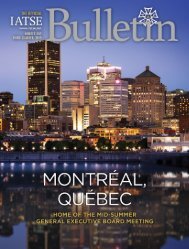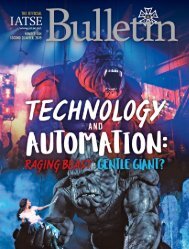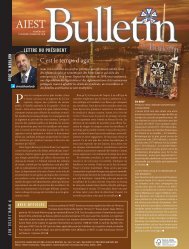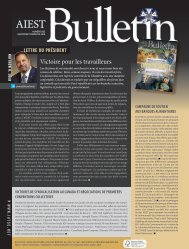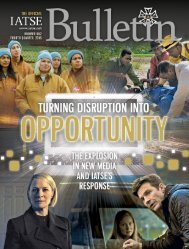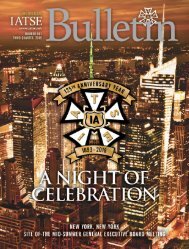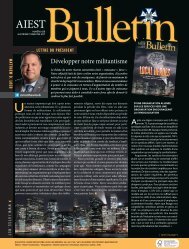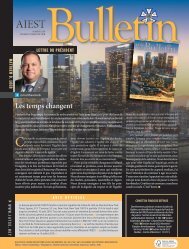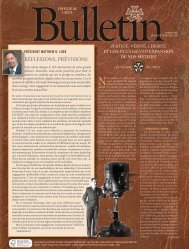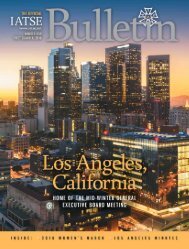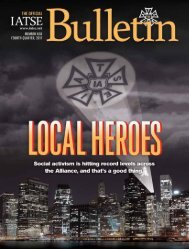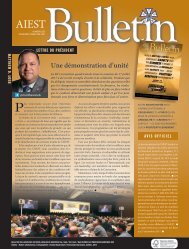IATSE-2nd2018_web
Create successful ePaper yourself
Turn your PDF publications into a flip-book with our unique Google optimized e-Paper software.
For the carpenters, scene shifters, flypeople, electricians,<br />
property workers and other stagehands who worked on this production<br />
and hundreds of others around the U.S. and Canada,<br />
jobs were (with apologies to Thomas Hobbes) nasty, brutish and<br />
short, albeit with long hours.<br />
The most experienced stagehands received 50 cents a day.<br />
They were expected to work around the clock, often without<br />
meals or breaks. They labored in virtually every department<br />
of the theater. After opening night, many stagehands who had<br />
worked so hard to load the show were sent on their way, with no<br />
promise of future work.<br />
They even faced competition from unpaid child labor, as<br />
young boys were often enlisted to help work the show or take<br />
small parts as extras, all in exchange for “free” tickets.<br />
To remedy these injustices ... to improve their horrible working<br />
conditions ... and to empower stagehands to improve their<br />
lives and have a voice in the workplace ... seventeen courageous<br />
individuals made a bold decision. They would risk their jobs,<br />
their homes, even their ability to work in their chosen field for<br />
an idea whose time has come.<br />
Their idea is embodied in a single word: Union.<br />
And so on July 17, 1893, the group of seventeen met in New<br />
York City as the delegates to the first convention of the National<br />
Alliance of Theatrical Stage Employes. 1 They came from<br />
Boston, Brooklyn, Buffalo, Chicago, Cincinnati, Denver, New<br />
York, Philadelphia, Pittsburgh, St. Louis and Syracuse. Together,<br />
they pledged to support each other’s efforts to establish fair<br />
wages and working conditions for their members.<br />
For today’s 140,000 proud members of the union they<br />
founded, no event had a greater, more long-lasting and transformative<br />
impact on their craft, careers and well-being. For the<br />
wages, benefits, working conditions, rights and voice on the job<br />
that we enjoy today, every one of us owes these founders of our<br />
great union an incalculable debt of thanks.<br />
Tough as it is to organize, bargain and advocate in 2018, there<br />
is simply no comparison to the state of our industry in 1893.<br />
A small group of managers and producers had an iron grip on<br />
most of the entertainment industry. They could fire workers for<br />
any cause, let alone trying to form a union to advocate for better<br />
pay and working conditions. (The National Labor Relations Act<br />
was still forty-two years away.)<br />
But they had already taken important strides toward the<br />
goal of empowering all stagehands with union representation. In<br />
1888, a predecessor to <strong>IATSE</strong> had been founded, the Theatrical<br />
Protective Union of New York (now <strong>IATSE</strong> Local One). A work<br />
stoppage at the Bowery Theatre, a walkout at Wallack’s Theatre<br />
and a strike at the Academy of Music on 14th Street put muscle<br />
behind the union’s demand of a dollar a show and 50 cents for<br />
each load in and load out. Strikebreakers were hired. When a flat<br />
dropped on acclaimed actor Louis James during Hamlet’s soliloquy,<br />
the actor reportedly stormed into his dressing room and<br />
told management that he would not return to the stage until the<br />
professional stagehands were reinstated. They were. The bond<br />
between stagehands and actors, still solid today, was made fast. 2<br />
Five years later, joining together with sixteen other local<br />
unions was the logical next step to build worker strength and<br />
bargain on a more equal footing with a relatively small number<br />
of powerful employers.<br />
Delegates to the first Convention elected John G. Williams<br />
president. It was an unpaid position at the time and typically<br />
turned over annually at each convention. In 1894, delegates to<br />
the second Convention elected Lee M. Hart of Chicago, who<br />
1<br />
In 2001, delegates to the International Convention changed “Employes” to “Employees” in the Alliance’s full name, reflecting the modern spelling of the word as<br />
opposed to the old English version.<br />
2<br />
Source: https://iatselocalone.org/public/About-Local-One/History-of-Local-One<br />
7



